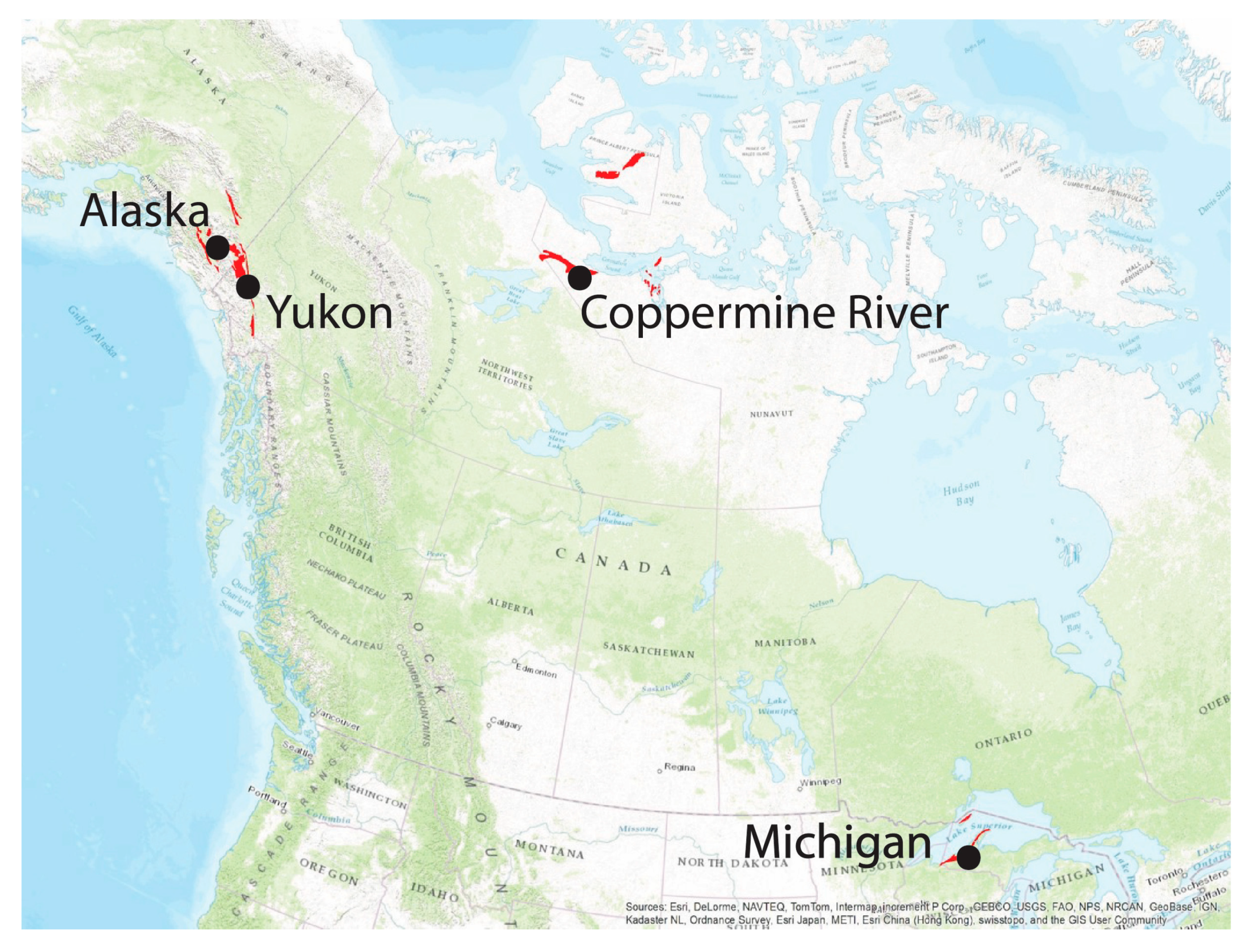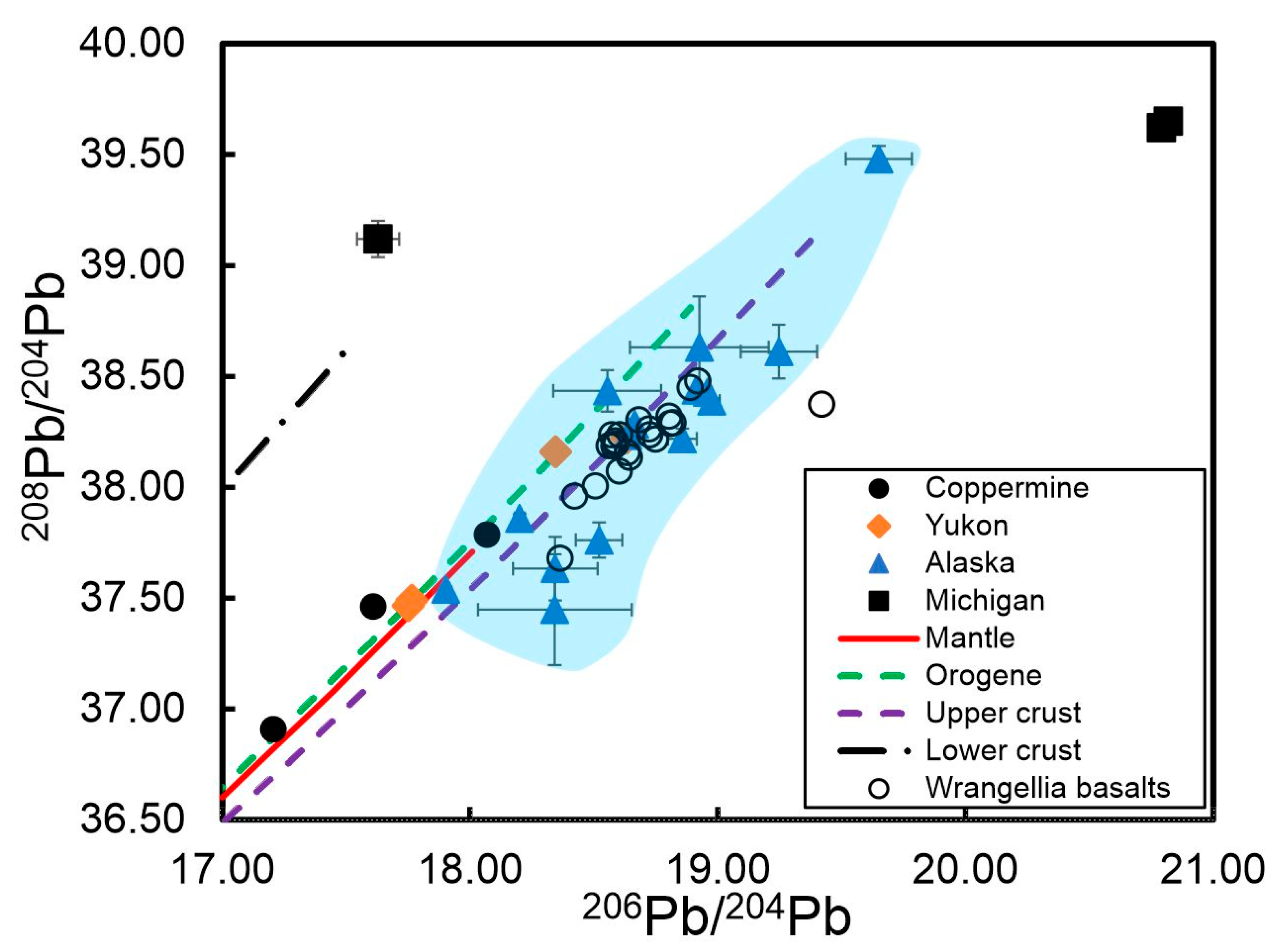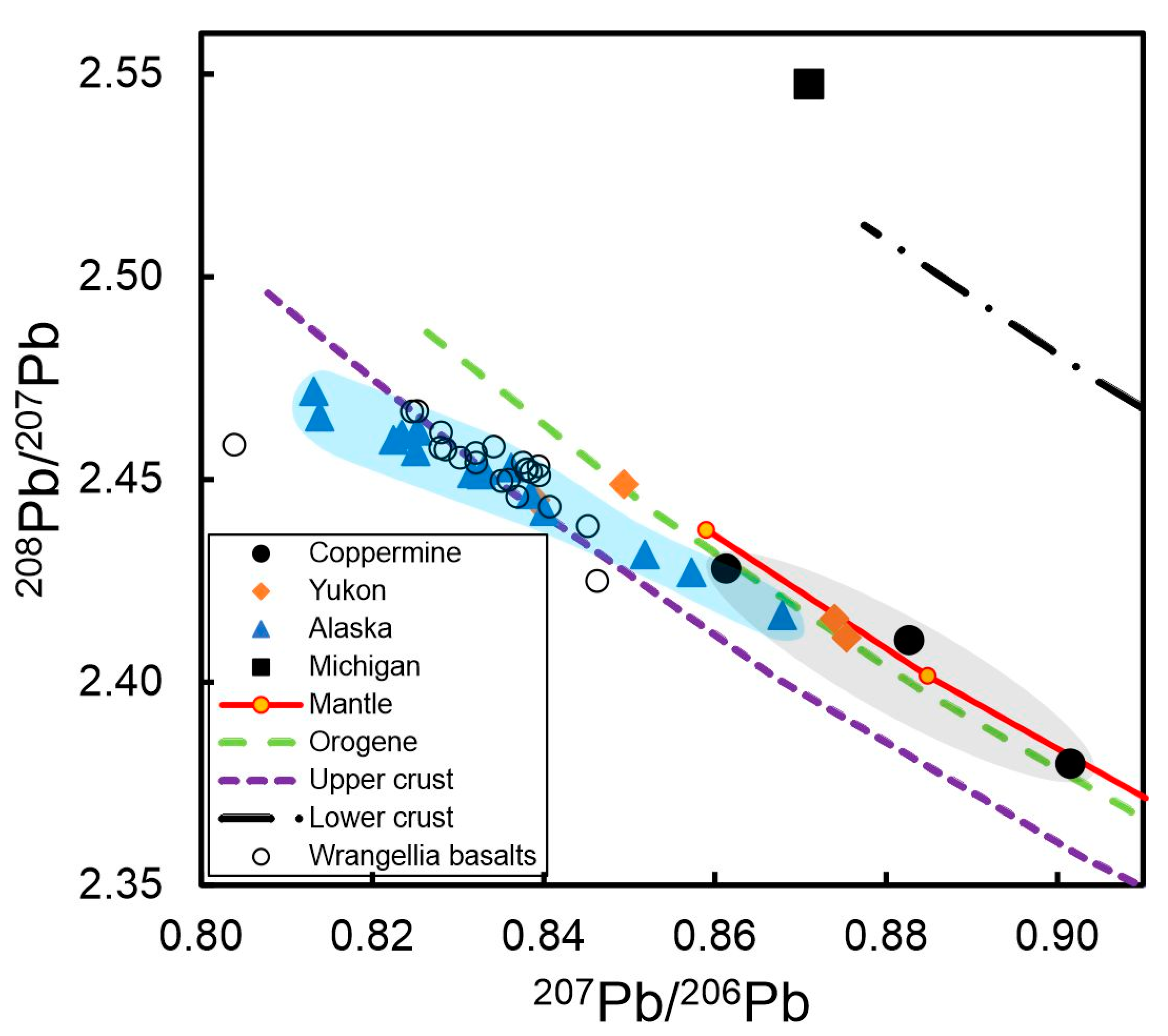Lead Isotope Analysis of Geological Native Copper: Implications for Archaeological Provenance Research in the North American Arctic and Subarctic
Abstract
1. Introduction
2. Native Copper Geology and Provenance in the Far North
3. Pb Isotope Analysis of Native Copper
4. Geological Background
5. Materials and Methods
6. Results
7. Conclusions
Author Contributions
Funding
Data Availability Statement
Acknowledgments
Conflicts of Interest
References
- Grinev, A.V. On the Banks of the Copper River: The Ahtna Indians and the Russians, 1783–1867. Arctic. Anthropol. 1993, 30, 54–66. [Google Scholar]
- Hearne, S. A Journey from Prince of Wale’s Fort in Hudson’s Bay to the Northern Ocean, 1769, 1770, 1771, 1772; McMillan: Toronto, ON, Canada, 1958. [Google Scholar]
- Pratt, K. Copper, Trade, and Tradition among the Lower Ahtna of the Chitina River Basin: The Nicolai Era, 1884–1900. Arctic. Anthropol. 1998, 35, 77–98. [Google Scholar]
- de Laguna, F. Archaeology of Cook Inlet; The University Museum, University of Pennsylvania Press: Philadelphia, PA, USA, 1934. [Google Scholar]
- McGhee, R. Copper Eskimo Prehistory; Publications in Archaeology, No. 2; National Museums of Canada: Ottawa, ON, Canada, 1972. [Google Scholar]
- Rainey, F.G. Archaeology in Central Alaska. Anthropol. Pap. Am. Mus. Nat. Hist. 1939, 36, 353–405. [Google Scholar]
- Taylor, W.E., Jr. Summary of Archaeological Field Work on Banks and Victoria Islands, Arctic Canada, 1965. Arctic. Anthropol. 1967, 4, 221–243. [Google Scholar]
- Rapp, G.; Allert, J.; Vitali, V.; Jing, Z.; Henrickson, E. Determining Geologic Sources of Artifact Copper: Source Characterization Using Trace Element Patterns; University Press of America: Lanhan, MD, USA, 2000. [Google Scholar]
- Wayman, M.L. Native Copper: Humanity’s Introduction to Metallurgy? In All That Glitters: Readings in Historical Metallurgy; Wayman, M.L., Ed.; Canadian Institute of Mining and Metallurgy: Montreal, QC, Canada, 1989; pp. 3–6. [Google Scholar]
- Cooper, H.K. Innovation and Prestige among Northern Hunter-Gatherers: Late Prehistoric Native Use in Alaska and Yukon. Am. Antiq. 2012, 77, 565–590. [Google Scholar] [CrossRef][Green Version]
- Franklin, U.M.; Badone, E.; Gotthardt, R.; Yorga, B. An Examination of Prehistoric Copper Technology and Copper Sources in Western Arctic and Subarctic North America; National Museums of Man: Ottawa, ON, Canada, 1981. [Google Scholar]
- Pike, M. Continuity and Change in Indigenous Copper Technologies of the Arctic and Central Subarctic. Ph.D. Thesis, Purdue University, West Lafayette, IN, USA, August 2020. [Google Scholar]
- Pike, M.; Cooper, H.K.; Hunt, G. Defining a ‘reasonable geographic framework’: Path Distance as native copper provenance in the Arctic, Subarctic, and Northwest Coast. JAS 2019, 26, 101903. [Google Scholar] [CrossRef]
- Rapp, G., Jr.; Hill, C. Geoarchaeology: The Earth Science Approach to Archaeological Interpretation; Yale University Press: New Haven, CT, USA, 1998. [Google Scholar]
- Halsey, J. Copper from the Drift. In Proceedings of the Joint 50th Midwest Archaeological Conference and the 61st Annual Meeting of the Southeastern Archaeological Conference, St. Louis, MO, USA, 21 October 2004. [Google Scholar]
- Cooper, H.K.; Duke, M.J.M.; Simonetti, A.; Chen, G. Trace element and Pb isotope provenance analyses of native copper in northwestern North America: Results of a recent pilot study using INAA, ICP-MS, and LA-MC-ICP-MS. J. Archaeol. Sci. 2008, 35, 1732–1747. [Google Scholar] [CrossRef]
- Rapp, G., Jr.; Henrickson, E.; Allert, J. Native copper sources of artifact copper in pre-Columbian North America. In Archaeological Geology of North America; Lasca, N., Donahue, J., Eds.; Geological Society of America: Boulder, CO, USA, 1990; pp. 479–498. [Google Scholar]
- Killick, D.; Stephens, J.A.; Fenn, T.R. Geological Constraints on the use of Lead Isotopes for Provenance in Archaeometallurgy. Archaeometry 2020, 62, 86–105. [Google Scholar] [CrossRef]
- Artioli, G.; Canovaro, C.; Nimis, P.; Angelini, I. LIA of Prehistoric Metals in the Central Mediterranean Area: A Review. Archaeometry 2020, 62, 53–85. [Google Scholar] [CrossRef]
- Faure, G.; Mensing, T.M. Isotope Principle and Applications, 3rd ed.; John Wiley & Sons: Hoboken, NJ, USA, 2005. [Google Scholar]
- MacKevett, E.M., Jr.; Cox, D.P.; Potter, R.W.I.; Silberman, M.L. Kennecott-type Deposits in the Wrangell Mountains, Alaska: High-Grade Copper Ores Near a Basalt-Limestone Contact. Econ. Geo. 1997, 9, 66–89. [Google Scholar]
- Price, J.B.; Hitzman, M.W.; Nelson, E.P.; Humphrey, J.D.; Johnson, C.A. Wall-Rock Alteration, Structural Control, and Stable Isotope Systematics of the High-Grade Copper Orebodies of the Kennecott District, Alaska. Econ. Geo. 2014, 109, 581–620. [Google Scholar] [CrossRef]
- Kindle, E.D. Classification and Description of Copper Deposits, Coppermine River Area, District of Mackenzie, Bulletin 214; Geological Survey of Canada: Ottawa, ON, Canada, 1972.
- Skulski, T.; Rainbird, R.H.; Turner, E.C.; Meek, R.; Ielpi, A.; Halverson, G.P.; Davis, W.J.; Mercadier, J.; Girard, E.; Loron, C.C. Bedrock Geology of the Dismal Lakes-Lower Coppermine River Area, Nunavut and Northwest Territories: GEM-@ Coppermine River Transect; Report of Activities 2017–2018; Geological Survey of Canada: Ottawa, ON, Canada, 2018.
- Wanless, R.K.; Stevens, R.D.; Lachance, G.R.; Rimsaite, J.Y.J. Age Determinations and Geological Studies; Technical Report for Geological Survey of Canada: Ottawa, ON, Canada, 1965; p. 64.
- Simonetti, A.; Gariépy, C.; Banic, C.; Tanabe, R.; Wong, H.K. Pb Isotopic Investigation of Aircraft-Sampled Emissions from the Horne Smelter (Rouyn, Québec): Implications for Atmospheric Pollution in Northeastern North America. Geochim. Cosmochim. Acta 2004, 68, 3285–3294. [Google Scholar] [CrossRef]
- Baker, J.; Peate, D.; Waight, T.; Meyzen, C. Pb isotopic analysis of standards and samples using a 207Pb–204Pb double spike and thallium to correct for mass bias with a double-focusing MC-ICP-MS. Chem. Geol. 2004, 211, 275–303. [Google Scholar] [CrossRef]
- Zartman, R.E.; Doe, B.R. Plumbotectonics—The Model. Tectonophysics 1981, 75, 135–162. [Google Scholar] [CrossRef]
- Greene, A.R.; Scoates, J.S.; Weis, D. Wrangellia flood basalts in Alaska: A record of plume-lithosphere interaction in a Late Triassic accreted oceanic plateau. Geochem. Geophys. Geosys. 2008, 9, 1–34. [Google Scholar] [CrossRef]
- Stacey, J.S.; Kramers, J.D. Approximation of Terrestrial Lead Isotope Evolution by a Two-Stage Model. Earther Planet. Sci. Lett. 1975, 26, 207–221. [Google Scholar] [CrossRef]
- Bornhorst, T.J.; Barron, R.J. Copper Deposits of the Western Upper Peninsula Michigan. In Geological Society of America Field Guide; Miller, J.D., Hudak, G.J., Wittkop, C., McLaughlin, P.I., Eds.; The Geological Society of America: Boulder, CO, USA, 2011; Volume 24, pp. 83–99. [Google Scholar] [CrossRef]




| Sample Name | 206Pb/204Pb | 2s Error | 207Pb/204Pb | 2s Error | 208Pb/204Pb | 2s Error | 208Pb/206Pb | 2s Error | 207Pb/206Pb | 2s Error | Total Beam (V) |
|---|---|---|---|---|---|---|---|---|---|---|---|
| Standards | |||||||||||
| NBS 981 + Tl 25/6.25 ppb-1 | 16.936 | 0.001 | 15.488 | 0.001 | 36.688 | 0.002 | 2.16624 | 0.00005 | 0.91448 | 0.00002 | 6.33 |
| NBS 981 + Tl 25/6.25 ppb-2 | 16.936 | 0.001 | 15.489 | 0.001 | 36.691 | 0.001 | 2.16644 | 0.00003 | 0.91456 | 0.00001 | 10.4 |
| NBS 981 + Tl 25/6.25 ppb-3 | 16.934 | 0.001 | 15.488 | 0.001 | 36.687 | 0.002 | 2.16643 | 0.00003 | 0.91456 | 0.00001 | 13.4 |
| Yukon | |||||||||||
| Steep Creek Mayo | 18.632 | 0.002 | 15.633 | 0.002 | 38.222 | 0.005 | 2.0514 | 0.0001 | 0.83904 | 0.00003 | 6.19 |
| Burwash Creek Nugget 1 | 17.750 | 0.004 | 15.511 | 0.004 | 37.466 | 0.011 | 2.1112 | 0.0001 | 0.87396 | 0.00003 | 1.50 |
| Burwash Creek | 18.345 | 0.008 | 15.583 | 0.006 | 38.160 | 0.016 | 2.0800 | 0.0002 | 0.84938 | 0.00004 | 1.25 |
| 12 Fourth of July Creek Nugget 1 | 17.764 | 0.001 | 15.550 | 0.001 | 37.490 | 0.002 | 2.1104 | 0.0001 | 0.87533 | 0.00001 | 5.24 |
| Coppermine River | |||||||||||
| Nunavut1 | 18.068 | 0.009 | 15.563 | 0.007 | 37.788 | 0.018 | 2.0912 | 0.0002 | 0.86129 | 0.00009 | 1.00 |
| Nunavut2 | 17.609 | 0.001 | 15.543 | 0.001 | 37.464 | 0.004 | 2.1275 | 0.0001 | 0.88266 | 0.00002 | 13.8 |
| Nunavut3 | 17.205 | 0.001 | 15.510 | 0.002 | 36.910 | 0.005 | 2.1455 | 0.0002 | 0.90152 | 0.00004 | 7.15 |
| Michigan | |||||||||||
| 23 MI | 20.819 | 0.001 | 15.864 | 0.002 | 39.650 | 0.006 | 1.9045 | 0.00014 | 0.76196 | 0.00003 | 67.1 |
| 24 MI | 17.629 | 0.085 | 15.377 | 0.082 | 39.120 | 0.188 | 2.2188 | 0.00090 | 0.87097 | 0.00056 | 0.09 |
| 25 MI | 20.791 | 0.001 | 15.857 | 0.001 | 39.622 | 0.005 | 1.9057 | 0.00012 | 0.76271 | 0.00003 | 78.1 |
| Alaska | |||||||||||
| Chititu Creek 30-21-27BV | 19.246 | 0.154 | 15.660 | 0.121 | 38.612 | 0.306 | 2.0065 | 0.0019 | 0.81383 | 0.00081 | 0.03 |
| Chititu Creek 30-21-27BU | 18.200 | 0.020 | 15.605 | 0.019 | 37.860 | 0.042 | 2.0806 | 0.0001 | 0.85725 | 0.00007 | 0.29 |
| Chititu Creek 30-21-27BT | 17.902 | 0.012 | 15.535 | 0.011 | 37.541 | 0.030 | 2.0971 | 0.0003 | 0.86783 | 0.00006 | 0.66 |
| Chititu Creek 30-21-27AX | 18.664 | 0.021 | 15.608 | 0.008 | 38.284 | 0.022 | 2.0512 | 0.0001 | 0.83622 | 0.00005 | 0.27 |
| Chititu Creek 30-21-27AZ | 18.912 | 0.012 | 15.609 | 0.012 | 38.438 | 0.033 | 2.0318 | 0.0002 | 0.82526 | 0.00009 | 0.72 |
| 13 Dan Creek | 18.857 | 0.058 | 15.530 | 0.046 | 38.219 | 0.106 | 2.0265 | 0.0006 | 0.82342 | 0.00024 | 0.10 |
| 14 Dan Creek | 18.975 | 0.032 | 15.607 | 0.013 | 38.389 | 0.032 | 2.0231 | 0.0001 | 0.82247 | 0.00005 | 0.24 |
| 15 Dan Creek | 18.554 | 0.218 | 15.806 | 0.093 | 38.435 | 0.224 | 2.0712 | 0.0009 | 0.85182 | 0.00052 | 0.02 |
| 16 Dan Creek | 18.958 | 0.017 | 15.640 | 0.008 | 38.428 | 0.018 | 2.0271 | 0.0001 | 0.82506 | 0.00009 | 0.38 |
| 17 Dan Creek | 18.636 | 0.015 | 15.624 | 0.007 | 38.234 | 0.018 | 2.0511 | 0.0001 | 0.83845 | 0.00008 | 0.32 |
| 18 Kletsan | 19.650 | 0.134 | 15.989 | 0.058 | 39.481 | 0.137 | 2.0099 | 0.0007 | 0.81316 | 0.00041 | 0.03 |
| 19 Kletsan | 18.344 | 0.171 | 15.417 | 0.144 | 37.633 | 0.350 | 2.0516 | 0.0014 | 0.84008 | 0.00076 | 0.03 |
| 20 Kletsan | 18.521 | 0.094 | 15.401 | 0.079 | 37.762 | 0.193 | 2.0387 | 0.0009 | 0.83161 | 0.00034 | 0.06 |
| 21 Kletsan | 18.925 | 0.280 | 15.752 | 0.230 | 38.631 | 0.570 | 2.0412 | 0.0018 | 0.83272 | 0.00102 | 0.03 |
| 22 Kletsan | 18.342 | 0.310 | 15.211 | 0.250 | 37.448 | 0.638 | 2.0427 | 0.0026 | 0.83297 | 0.00148 | 0.02 |
Publisher’s Note: MDPI stays neutral with regard to jurisdictional claims in published maps and institutional affiliations. |
© 2021 by the authors. Licensee MDPI, Basel, Switzerland. This article is an open access article distributed under the terms and conditions of the Creative Commons Attribution (CC BY) license (https://creativecommons.org/licenses/by/4.0/).
Share and Cite
Cooper, H.K.; Simonetti, A. Lead Isotope Analysis of Geological Native Copper: Implications for Archaeological Provenance Research in the North American Arctic and Subarctic. Minerals 2021, 11, 667. https://doi.org/10.3390/min11070667
Cooper HK, Simonetti A. Lead Isotope Analysis of Geological Native Copper: Implications for Archaeological Provenance Research in the North American Arctic and Subarctic. Minerals. 2021; 11(7):667. https://doi.org/10.3390/min11070667
Chicago/Turabian StyleCooper, H. Kory, and Antonio Simonetti. 2021. "Lead Isotope Analysis of Geological Native Copper: Implications for Archaeological Provenance Research in the North American Arctic and Subarctic" Minerals 11, no. 7: 667. https://doi.org/10.3390/min11070667
APA StyleCooper, H. K., & Simonetti, A. (2021). Lead Isotope Analysis of Geological Native Copper: Implications for Archaeological Provenance Research in the North American Arctic and Subarctic. Minerals, 11(7), 667. https://doi.org/10.3390/min11070667







